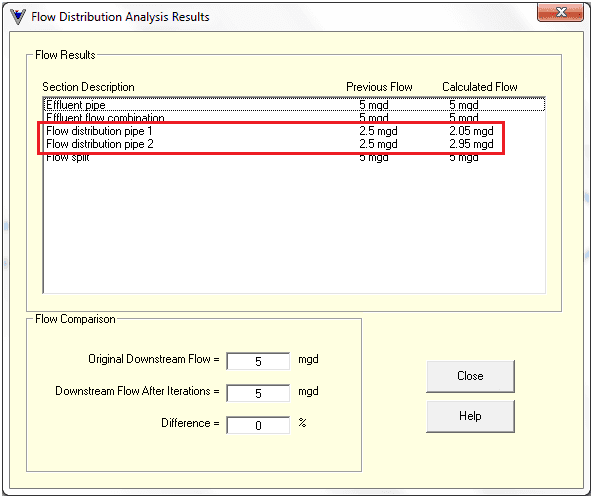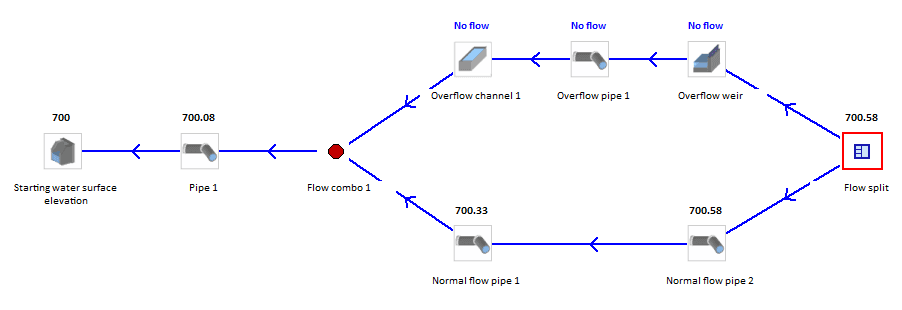The most complex analysis feature in Visual Hydraulics is the development of the flow split distribution analysis tool. It also represents one of the most challenging tasks in treatment plant analysis. Although proper design procedures stress the need for measures to be implemented to insure appropriate flow split between multiple units, this often does not occur and may not even be possible.
The hydraulic process of analyzing how flow is distributed among various paths can be extraordinarily complex, depending on the nature of the flow paths and the number of flow paths that must be calibrated throughout the hydraulic profile. Visual Hydraulics uses the concept of "equalized head", which is the principle that the flow will be distributed among various paths until the water elevation upstream of all of those paths has achieved an equal water surface elevation. Therefore if more head is required to pass flow through one path, less flow will be conveyed to that path and more flow will be conveyed to the path that requires less head. A balanced system has equal head losses across all flow paths and the sum of the flows through each flow path will add up to the total flow.
Consider the following very basic flow path split:

In the scenario above, the system is considered to be balanced. The water surface elevations downstream of the flow split are equal, therefore the amount of flow being conveyed to each path is correct. This is a very simple case, with the two pipes comprising the separate flow paths being exactly equal. If a simple change is made to the profile so that the pipes are not equal, the water surface elevations for each pipe will vary:

In this case, the water surface elevations upstream of the two pipes are not equal, and this system is therefore unbalanced in terms of flows. More flow should be conveyed through flow distribution pipe 2 than flow distribution pipe 1, and vice versa. The challenge lies in determining how much flow should be distributed through each path, and that's when the flow distribution tool provided within Visual Hydraulics can be used. The user would simply instruct the software to perform a flow distribution analysis on the hydraulic profile, and when this is done, the software will determine the appropriate flow for you:

The example presented previously is the most simplistic case of a flow distribution analysis. Most flow distribution analyses are much more complex and involve items such as weirs, flow paths off-line, and many flow splits and flow paths to consider. Visual Hydraulics has been designed to handle a variety of flow split scenarios. An example of a unique flow split situation is the scenario where no flow may be conveyed to a flow path. This type of situation could occur if an overflow path exists in the hydraulic profile. Consider the following sample hydraulic profile:

In the example above, the normal mode of operation would be for all of the flow to follow the "normal path", or lower path. The flow path with the "overflow weir" element would only come on-line if high flows were encountered. In this case, the user guesses that portion of the flow will go through the bypass path, with the remaining flow being conveyed through the normal path. To check that assumption, a flow distribution analysis can then be performed:

As can be seen from the adjusted hydraulic profile, it turns out that the bypass weir ("overflow weir") actually does not receive any flow because the other flow path can safely pass all of the flow before the weir elevation is reached. If this situation is encountered by the software, the path will display a "No Flow" label above the hydraulic element so the user is made aware that flow is not conveyed to that section of the profile.
The flow split analysis tool is the most advanced and complex tool we have ever had as part of our Visual Hydraulics software. Take the guesswork out of hydraulic profiles with multiple flow paths...let Visual Hydraulics do the work for you!
